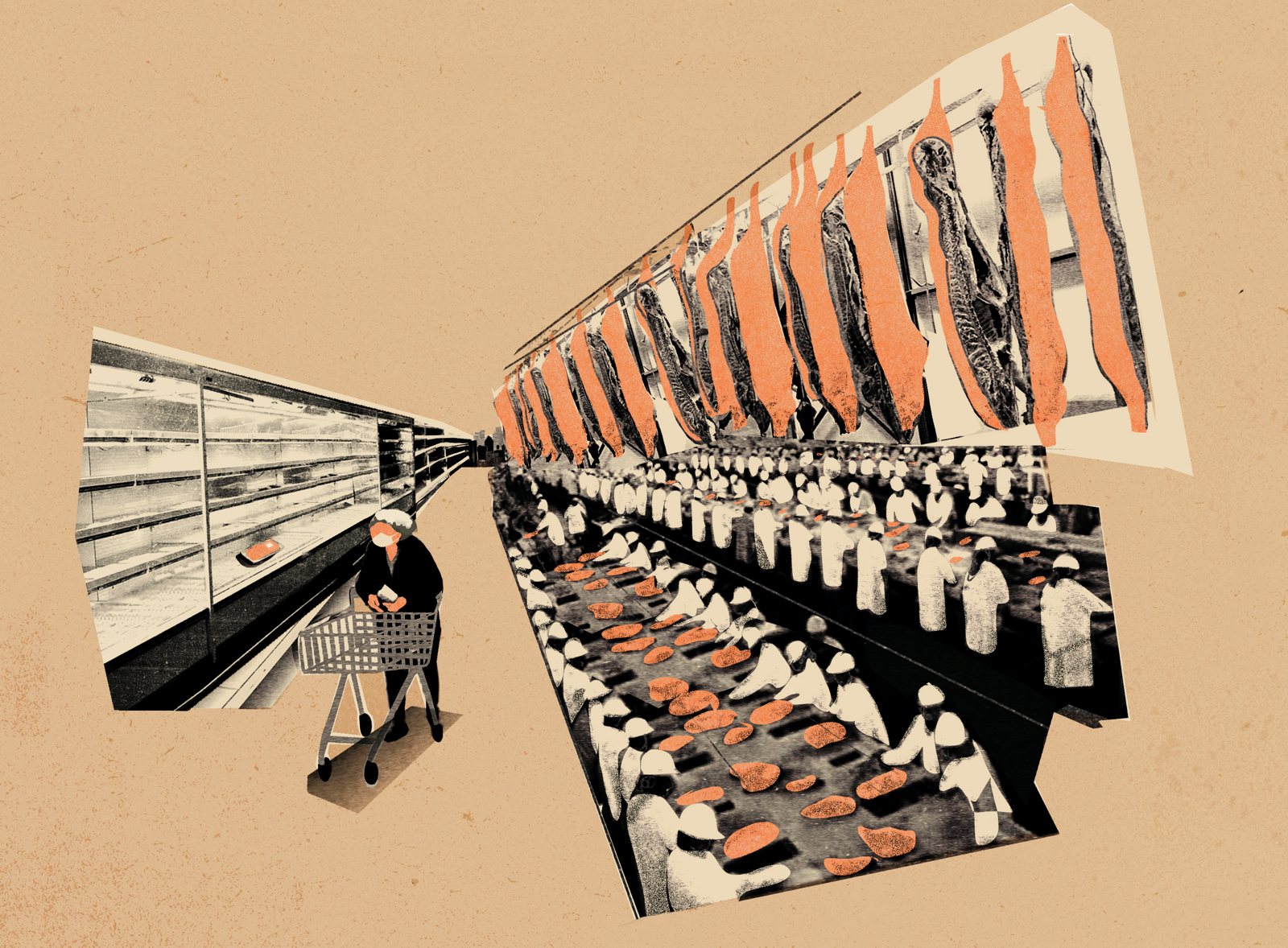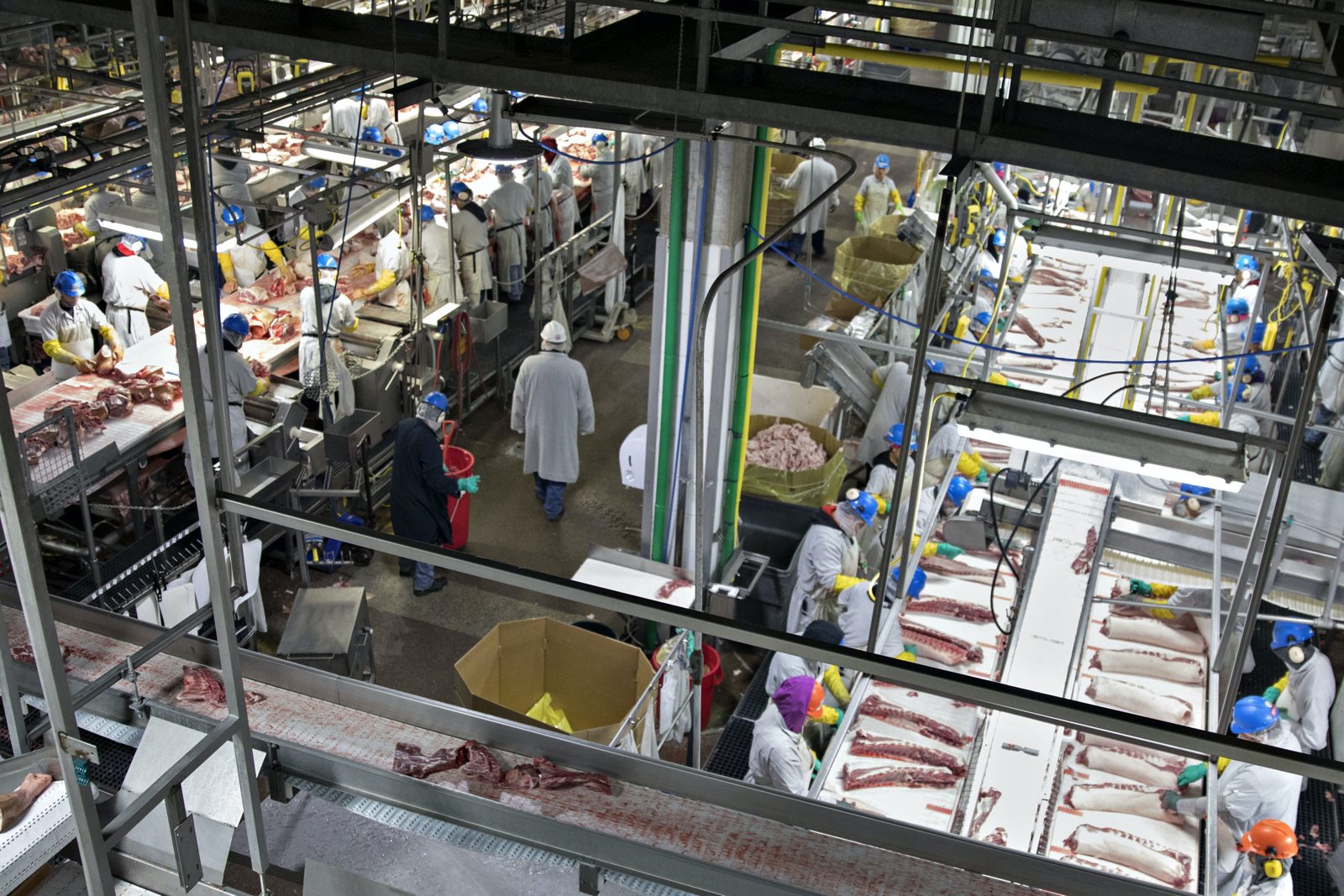“Only when the tide goes out,” Warren Buffett observed, “do you discover who’s been swimming naked.” For our society, the Covid-19 pandemic represents an ebb tide of historic proportions, one that is laying bare vulnerabilities and inequities that in normal times have gone undiscovered. Nowhere is this more evident than in the American food system. A series of shocks has exposed weak links in our food chain that threaten to leave grocery shelves as patchy and unpredictable as those in the former Soviet bloc. The very system that made possible the bounty of the American supermarket—its vaunted efficiency and ability to “pile it high and sell it cheap”—suddenly seems questionable, if not misguided. But the problems the novel coronavirus has revealed are not limited to the way we produce and distribute food. They also show up on our plates, since the diet on offer at the end of the industrial food chain is linked to precisely the types of chronic disease that render us more vulnerable to Covid-19.
The juxtaposition of images in the news of farmers destroying crops and dumping milk with empty supermarket shelves or hungry Americans lining up for hours at food banks tells a story of economic efficiency gone mad. Today the US actually has two separate food chains, each supplying roughly half of the market. The retail food chain links one set of farmers to grocery stores, and a second chain links a different set of farmers to institutional purchasers of food, such as restaurants, schools, and corporate offices. With the shutting down of much of the economy, as Americans stay home, this second food chain has essentially collapsed. But because of the way the industry has developed over the past several decades, it’s virtually impossible to reroute food normally sold in bulk to institutions to the retail outlets now clamoring for it. There’s still plenty of food coming from American farms, but no easy way to get it where it’s needed.
How did we end up here? The story begins early in the Reagan administration, when the Justice Department rewrote the rules of antitrust enforcement: if a proposed merger promised to lead to greater marketplace “efficiency”—the watchword—and wouldn’t harm the consumer, i.e., didn’t raise prices, it would be approved. (It’s worth noting that the word “consumer” appears nowhere in the Sherman Anti-Trust Act, passed in 1890. The law sought to protect producers—including farmers—and our politics from undue concentrations of corporate power.)1 The new policy, which subsequent administrations have left in place, propelled a wave of mergers and acquisitions in the food industry. As the industry has grown steadily more concentrated since the 1980s, it has also grown much more specialized, with a tiny number of large corporations dominating each link in the supply chain. One chicken farmer interviewed recently in Washington Monthly, who sells millions of eggs into the liquified egg market, destined for omelets in school cafeterias, lacks the grading equipment and packaging (not to mention the contacts or contracts) to sell his eggs in the retail marketplace.2 That chicken farmer had no choice but to euthanize thousands of hens at a time when eggs are in short supply in many supermarkets.
On April 26, John Tyson, the chairman of Tyson Foods, the second-largest meatpacker in America, took out ads in The New York Times and other newspapers to declare that the food chain was “breaking,” raising the specter of imminent meat shortages as outbreaks of Covid-19 hit the industry.3 Slaughterhouses have become hot zones for contagion, with thousands of workers now out sick and dozens of them dying.4 This should come as no surprise: social distancing is virtually impossible in a modern meat plant, making it an ideal environment for a virus to spread. In recent years, meatpackers have successfully lobbied regulators to increase line speeds, with the result that workers must stand shoulder to shoulder cutting and deboning animals so quickly that they can’t pause long enough to cover a cough, much less go to the bathroom, without carcasses passing them by. Some chicken plant workers, given no regular bathroom breaks, now wear diapers.5 A worker can ask for a break, but the plants are so loud he or she can’t be heard without speaking directly into the ear of a supervisor. Until recently slaughterhouse workers had little or no access to personal protective equipment; many of them were also encouraged to keep working even after exposure to the virus. Add to this the fact that many meat-plant workers are immigrants who live in crowded conditions with little or no access to health care, and you have a population at dangerously high risk of infection.
When the number of Covid-19 cases in America’s slaughterhouses exploded in late April—12,608 confirmed, with forty-nine deaths as of May 11—public health officials and governors began ordering plants to close. It was this threat to the industry’s profitability that led to Tyson’s declaration, which President Trump would have been right to see as a shakedown: the president’s political difficulties could only be compounded by a shortage of meat. In order to reopen their production lines, Tyson and his fellow packers wanted the federal government to step in and preempt local public health authorities; they also needed liability protection, in case workers or their unions sued them for failing to observe health and safety regulations.
Advertisement
Within days of Tyson’s ad, President Trump obliged the meatpackers by invoking the Defense Production Act. After having declined to use it to boost the production of badly needed coronavirus test kits, he now declared meat a “scarce and critical material essential to the national defense.” The executive order took the decision to reopen or close meat plants out of local hands, forced employees back to work without any mandatory safety precautions, and offered their employers some protection from liability for their negligence. On May 8, Tyson reopened a meatpacking plant in Waterloo, Iowa, where more than a thousand workers had tested positive.
The president and America’s meat eaters, not to mention its meat-plant workers, would never have found themselves in this predicament if not for the concentration of the meat industry, which has given us a supply chain so brittle that the closure of a single plant can cause havoc at every step, from farm to supermarket. Four companies now process more than 80 percent of beef cattle in America; another four companies process 57 percent of the hogs. A single Smithfield processing plant in Sioux Falls, South Dakota, processes 5 percent of the pork Americans eat. When an outbreak of Covid-19 forced the state’s governor to shut that plant down in April, the farmers who raise pigs committed to it were stranded.
Once pigs reach slaughter weight, there’s not much else you can do with them. You can’t afford to keep feeding them; even if you could, the production lines are designed to accommodate pigs up to a certain size and weight, and no larger. Meanwhile, you’ve got baby pigs entering the process, steadily getting fatter. Much the same is true for the hybrid industrial chickens, which, if allowed to live beyond their allotted six or seven weeks, are susceptible to broken bones and heart problems and quickly become too large to hang on the disassembly line. This is why the meat-plant closures forced American farmers to euthanize millions of animals, at a time when food banks were overwhelmed by demand.6
Under normal circumstances, the modern hog or chicken is a marvel of brutal efficiency, bred to produce protein at warp speed when given the right food and pharmaceuticals. So are the factories in which they are killed and cut into parts. These innovations have made meat, which for most of human history has been a luxury, a cheap commodity available to just about all Americans; we now eat, on average, more than nine ounces of meat per person per day, many of us at every meal.7 Covid-19 has brutally exposed the risks that accompany such a system. There will always be a tradeoff between efficiency and resilience (not to mention ethics); the food industry opted for the former, and we are now paying the price.
Imagine how different the story would be if there were still tens of thousands of chicken and pig farmers bringing their animals to hundreds of regional slaughterhouses. An outbreak at any one of them would barely disturb the system; it certainly wouldn’t be front-page news. Meat would probably be more expensive, but the redundancy would render the system more resilient, making breakdowns in the national supply chain unlikely. Successive administrations allowed the industry to consolidate because the efficiencies promised to make meat cheaper for the consumer, which it did. It also gave us an industry so powerful it can enlist the president of the United States in its efforts to bring local health authorities to heel and force reluctant and frightened workers back onto the line.
Another vulnerability that the novel coronavirus has exposed is the paradoxical notion of “essential” workers who are grossly underpaid and whose lives are treated as disposable. It is the men and women who debone chicken carcasses flying down a line at 175 birds a minute, or pick salad greens under the desert sun, or drive refrigerated produce trucks across the country who are keeping us fed and keeping the wheels of our society from flying off. Our utter dependence on them has never been more clear. This should give food and agricultural workers a rare degree of political leverage at the very moment they are being disproportionately infected. Scattered job actions and wildcat strikes are beginning to pop up around the country—at Amazon, Instacart, Whole Foods, Walmart, and some meat plants—as these workers begin to flex their muscle.8 This is probably just the beginning. Perhaps their new leverage will allow them to win the kinds of wages, protections, and benefits that would more accurately reflect their importance to society.
Advertisement
So far, the produce sections of our supermarkets remain comparatively well stocked, but what happens this summer and next fall, if the outbreaks that have crippled the meat industry hit the farm fields? Farmworkers, too, live and work in close proximity, many of them undocumented immigrants crammed into temporary quarters on farms. Lacking benefits like sick pay, not to mention health insurance, they often have no choice but to work even when infected. Many growers depend on guest workers from Mexico to pick their crops; what happens if the pandemic—or the Trump administration, which is using the pandemic to justify even more restrictions on immigration—prevents them from coming north this year?
The food chain is buckling. But it’s worth pointing out that there are parts of it that are adapting and doing relatively well. Local food systems have proved surprisingly resilient. Small, diversified farmers who supply restaurants have had an easier time finding new markets; the popularity of community-supported agriculture (CSA) is taking off, as people who are cooking at home sign up for weekly boxes of produce from regional growers. (The renaissance of home cooking, and baking, is one of the happier consequences of the lockdown, good news both for our health and for farmers who grow actual food, as opposed to commodities like corn and soy.) In many places, farmer’s markets have quickly adjusted to pandemic conditions, instituting social-distancing rules and touchless payment systems. The advantages of local food systems have never been more obvious, and their rapid growth during the past two decades has at least partly insulated many communities from the shocks to the broader food economy.
The pandemic is, willy-nilly, making the case for deindustrializing and decentralizing the American food system, breaking up the meat oligopoly, ensuring that food workers have sick pay and access to health care, and pursuing policies that would sacrifice some degree of efficiency in favor of much greater resilience. Somewhat less obviously, the pandemic is making the case not only for a different food system but for a radically different diet as well.
It’s long been understood that an industrial food system built upon a foundation of commodity crops like corn and soybeans leads to a diet dominated by meat and highly processed food. Most of what we grow in this country is not food exactly, but rather feed for animals and the building blocks from which fast food, snacks, soda, and all the other wonders of food processing, such as high-fructose corn syrup, are manufactured. While some sectors of agriculture are struggling during the pandemic, we can expect the corn and soybean crop to escape more or less unscathed. That’s because it takes remarkably little labor—typically a single farmer on a tractor, working alone—to plant and harvest thousands of acres of these crops. So processed foods should be the last kind to disappear from supermarket shelves.
Unfortunately, a diet dominated by such foods (as well as lots of meat and little in the way of vegetables or fruit—the so-called Western diet) predisposes us to obesity and chronic diseases such as hypertension and type-2 diabetes. These “underlying conditions” happen to be among the strongest predictors that an individual infected with Covid-19 will end up in the hospital with a severe case of the disease; the Centers for Disease Control and Prevention have reported that 49 percent of the people hospitalized for Covid-19 had preexisting hypertension, 48 percent were obese, and 28 percent had diabetes.9
Why these particular conditions should worsen Covid-19 infections might be explained by the fact that all three are symptoms of chronic inflammation, which is a disorder of the body’s immune system. (The Western diet is by itself inflammatory.) One way that Covid-19 kills is by sending the victim’s immune system into hyperdrive, igniting a “cytokine storm” that eventually destroys the lungs and other organs. A new Chinese study conducted in hospitals in Wuhan found that elevated levels of C-reactive protein, a standard marker of inflammation that has been linked to poor diet, “correlated with disease severity and tended to be a good predictor of adverse outcomes.”10
A momentous question awaits us on the far side of the current crisis: Are we willing to address the many vulnerabilities that the novel coronavirus has so dramatically exposed? It’s not hard to imagine a coherent and powerful new politics organized around precisely that principle. It would address the mistreatment of essential workers and gaping holes in the social safety net, including access to health care and sick leave—which we now understand, if we didn’t before, would be a benefit to all of us. It would treat public health as a matter of national security, giving it the kind of resources that threats to national security warrant.
But to be comprehensive, this post-pandemic politics would also need to confront the glaring deficiencies of a food system that has grown so concentrated that it is exquisitely vulnerable to the risks and disruptions now facing us. In addition to protecting the men and women we depend on to feed us, it would also seek to reorganize our agricultural policies to promote health rather than mere production, by paying attention to the quality as well as the quantity of the calories it produces. For even when our food system is functioning “normally,” reliably supplying the supermarket shelves and drive-thrus with cheap and abundant calories, it is killing us—slowly in normal times, swiftly in times like these. The food system we have is not the result of the free market. (There hasn’t been a free market in food since at least the Great Depression.) No, our food system is the product of agricultural and antitrust policies—political choices—that, as has suddenly become plain, stand in urgent need of reform.
—May 12, 2020
This Issue
June 11, 2020
What Kind of Country Do We Want?
The Pillage of India
-
1
This history is recounted in Barry C. Lynn, Cornered: The New Monopoly Capitalism and the Economics of Destruction (Wiley, 2011), pp. 135–138. ↩
-
2
See Claire Kelloway, “Why Are Farmers Destroying Food While Grocery Stores Are Empty?,” Washington Monthly, April 28, 2020. ↩
-
3
See “In America, the Virus Threatens a Meat Industry That Is Too Concentrated,” The Economist, April 30, 2020. ↩
-
4
See Leah Douglas, “Mapping Covid-19 in Meat and Food Processing Plants,” Food and Environmental Reporting Network (FERN), April 22, 2020. FERN has covered this story extensively and compiled statistics. Also see Esther Honig and Ted Genoways, “‘The Workers Are Being Sacrificed’: As Cases Mounted, Meatpacker JBS Kept People on Crowded Factory Floors,” FERN and Mother Jones, May 1, 2020. Civil Eats, FERN, and Mother Jones have done an excellent job of covering the outbreaks in the meat industry. ↩
-
5
See Magaly Licolli, “As Tyson Claims the Food Supply Is Breaking, Its Workers Continue to Suffer,” Civil Eats, April 30, 2020. ↩
-
6
See Tyler Whitley, “Don’t Blame Farmers Who Have to Euthanize Their Animals. Blame the Companies They Work For,” Civil Eats, April 30, 2020. ↩
-
7
It’s worth remembering that the federal government actively promotes meat consumption in myriad ways, from USDA advertising campaigns—“Beef: It’s What’s for Dinner”—to exempting feedlots from provisions of the Clean Water and Clean Air Acts, to the dietary guidelines it issues and the heavy subsidies it gives for animal feed. ↩
-
8
See, for example, Daniel A. Medina, “As Amazon, Walmart, and Others Profit Amid Coronavirus Crisis, Their Essential Workers Plan Unprecedented Strike,” The Intercept, April 28, 2020. ↩
-
9
See Shikha Garg et al., “Hospitalization Rates and Characteristics of Patients Hospitalized with Laboratory-Confirmed Coronavirus Disease 2019, COVID-NET, 14 States, March 1–30, 2020,” Morbidity and Mortality Weekly Report, Vol. 69, No. 15 (April 17, 2020). ↩
-
10
See Xiaomin Luo et al., “Prognostic Value of C-Reactive Protein in Patients with COVID-19,” medRxiv, March 23, 2020. The study has not yet been peer-reviewed. ↩





